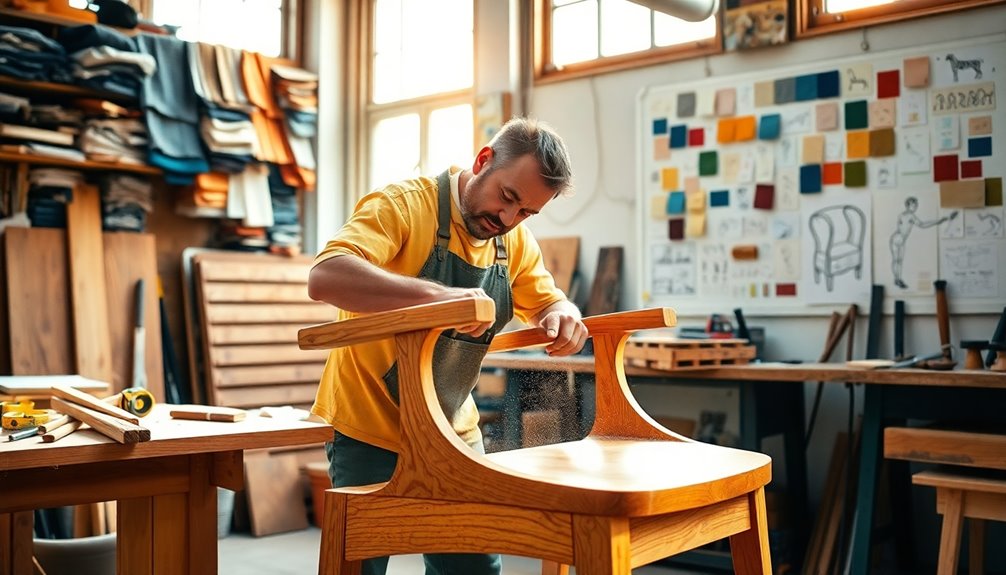To start a furniture business, you'll need to outline a solid plan and budget. Consider initial capital, which can range from $2,000 to $350,000, depending on your scale. Choose a strategic location, keeping overhead costs in mind. Invest in quality materials and establish strong relationships with suppliers. Focus on branding and market research to define your niche and target customers. Utilize effective marketing strategies, especially on social media, to engage your audience. Also, prioritize excellent customer service and efficient inventory management. As you move forward, you'll uncover vital insights for success.
Key Takeaways
- Determine your initial capital investment, including costs for materials, tools, labor, and overhead expenses based on your business scale and location.
- Conduct thorough market research to identify your target audience and refine your product offerings to meet their needs effectively.
- Develop a solid branding strategy that establishes your unique selling proposition and maintains a consistent image across all platforms.
- Implement effective inventory management practices to streamline operations and avoid excess storage fees while ensuring product availability.
- Focus on customer service excellence by training staff, creating personalized experiences, and establishing efficient communication channels for inquiries and support.
Initial Capital Investment

When launching a furniture business, understanding your initial capital investment is crucial to your success. Startup costs can range significantly, from as low as $2,000 to as high as $350,000, with a median around $20,000. If you plan to open a small retail store, expect costs between $50,000 to $100,000. For larger manufacturing operations, it's not uncommon to need $200,000 to $500,000.
Raw materials and equipment are major expenses. For instance, wood can cost $4 to $10 per board foot, while metal frames range from $2 to $6 per pound. Basic woodworking tools might set you back $2,000 to $10,000, and if you want high-end machinery like a CNC machine, budget $10,000 to $50,000. Additionally, it's important to remember that initial investment in materials typically falls between $10,000 and $20,000.
Labor costs also play a significant role in your investment. Skilled craftsmen typically earn $20 to $30 per hour, while general laborers cost $12 to $20 per hour. Don't forget to factor in additional staff costs, which can add $5,000 to $15,000 monthly. Careful budgeting for these elements will help ensure your furniture business starts on solid footing.
Location and Overhead Costs

Selecting the right location for your furniture business can significantly impact your overall costs and success. Urban or industrial areas typically have higher rent, ranging from $2,000 to $10,000 monthly, compared to rural locations. Being close to your suppliers can reduce transportation costs and improve efficiency, so consider that when choosing a site. Additionally, having a well-thought-out financial plan can help you determine how much you can afford to spend on your location.
Accessibility plays a crucial role, too. A location with good public transport or road networks will make it easier for both employees and customers to reach you. Look for areas with significant residential development or near housing complexes, as these locations attract homeowners who are more likely to purchase furniture.
Don't underestimate visibility and foot traffic; prime spots in city centers or high-traffic areas can enhance your store's exposure.
If you rent, remember your initial costs will include security deposits and the first month's rent, typically between $4,000 and $15,000. Monthly rent can account for up to 30% of your total expenses, so plan accordingly. For those considering purchasing a space, be prepared for higher upfront investments, along with closing and renovation costs.
Material Costs and Suppliers

Understanding material costs and suppliers is crucial for your furniture business's success. Raw material expenses can vary widely; for instance, quality hardwood typically costs between $4 to $10 per board foot, while metal frames can set you back $2 to $6 per pound. The type and quality of materials you choose will significantly impact your production costs. Although superior materials enhance aesthetics and durability, they also drive up expenses. Scarcity can further inflate procurement costs, affecting your overall pricing strategy. Additionally, it's important to recognize that higher-quality materials can increase production expenses, leading to elevated wholesale prices.
Finding reliable and cost-effective suppliers is essential. You might want to consider buying materials in bulk to reduce costs, but be prepared for the initial investment, which can range from $10,000 to $20,000 for adequate inventory. It's wise to work with multiple suppliers to compare prices and ensure quality. Vetting suppliers for reliability will safeguard your production process. Additionally, effective inventory management is key; keep an eye on material costs and monitor levels to avoid excessive storage fees. By forecasting your material needs based on market demand, you can maintain a continuous supply of materials without disruptions, ultimately supporting your business's profitability.
Branding and Market Research

After securing your materials and establishing reliable suppliers, the next step involves building a strong brand and conducting thorough market research. First, define your brand's category—are you focusing on office furniture, outdoor living, or home accents? Pinpoint specific products like sofa beds or dining tables and establish your brand's style, whether it's mid-century modern or rustic.
Next, identify your target customers. Are they students, apartment dwellers, or cottage owners? This clarity helps you refine your niche, like offering smart furniture or eco-friendly options. Conduct comprehensive market research to understand both local and global furniture markets. Analyze where your potential customers shop and which social channels they frequent. Additionally, implementing SEO best practices in your online presence can significantly increase your visibility to potential customers.
Assess the demand in your area if you plan to sell locally and identify competitors. What makes your brand unique? Develop a unique selling proposition that sets you apart. Stay updated on trends in furniture design and ecommerce to inform your branding decisions. Articulate your brand statement, craft a compelling brand story, and ensure a consistent brand image across all materials. This groundwork will help you create a strong foundation for your furniture business.
Marketing Strategies

Effective marketing strategies are crucial for launching and growing your furniture business in today's competitive landscape. Start by optimizing your website; ensure it's user-friendly, mobile-responsive, and quick to load. Integrate SEO practices to boost your search engine rankings and showcase customer reviews to build trust. Paid search can also help you target relevant keywords effectively.
Leverage social media to connect with your audience. Use YouTube for engaging videos that link directly to your product pages, and create short TikTok videos highlighting unique furniture features. Encourage customers to share images of their purchases on Instagram, and consider running targeted Facebook ads to reach potential buyers. Don't forget about Pinterest, where you can showcase customer-generated images of styled rooms. Additionally, understanding customer pain points can enhance your ad relevance and lead to higher conversion rates. Utilizing data-driven marketing strategies can also help you refine your approach and improve customer engagement.
Incorporate technology, like augmented reality, to allow customers to visualize how furniture fits in their homes. Virtual showrooms and 3D models can enhance their shopping experience while reducing return rates.
Lastly, collaborate with local influencers to expand your reach. Encourage user-generated content by inviting customers to share their stories and experiences, and consider running contests to boost engagement. These strategies will help you create a strong presence in the market.
Operational Setup

Setting up the operations of your furniture business is key to ensuring smooth and efficient functioning. Start by identifying major processes, breaking them into categories like retail, facilities management, and customer relationship management (CRM). For each category, define the specific activities needed and arrange them logically.
Quality control is essential. Implement processes that guarantee the design, production, and display of your furniture meet high standards. Don't overlook the service environment; create a welcoming atmosphere with amenities like snacks or coffee to enhance the shopping experience.
Next, organize departments effectively. Your merchandising and inventory team should manage selection and display, while facilities management ensures the store remains clean and attractive. Establish efficient billing and payment systems to streamline transactions.
Staffing is crucial; define roles and responsibilities clearly. Build a well-rounded team, including design, marketing, sales, and delivery personnel. Provide training to enhance skills, and set performance evaluation standards to monitor effectiveness. A comprehensive business plan acts as a roadmap for these operations, guiding your strategic decisions.
Lastly, develop standard operating procedures (SOPs) using easy-to-understand formats. These will help manage inventory costs and ensure tasks are executed sequentially and efficiently. Regularly update stock registers and coordinate with your supply chain for timely deliveries.
Inventory Management

Managing inventory effectively is crucial for the success of your furniture business. Start by categorizing your inventory using ABC classification: group items as A (high value), B (medium value), and C (low value). This helps you prioritize control efforts based on value. Analyze the diverse types of furniture you offer to understand lead times, storage needs, and carrying costs.
Next, conduct a seasonality analysis by examining historical sales data. Identify trends and fluctuations to avoid overstocking or understocking during peak seasons. Utilize demand forecasting tools to predict future sales accurately, incorporating external factors like economic conditions and emerging design trends. Implementing real-time tracking can further enhance your understanding of inventory dynamics.
Optimize your warehouse layout by implementing efficient storage solutions, such as vertical shelving and designated zones for different categories. Use clear labeling systems and designated picking routes to streamline operations and reduce errors.
Finally, embrace technology by integrating real-time inventory systems and utilizing barcodes or QR codes for efficient transactions. Mobile apps can help you manage inventory on the go, while automated reporting saves you time and resources. By taking these steps, you'll maintain optimal stock levels and enhance your business's overall efficiency.
Customer Service Essentials

While establishing a successful furniture business, prioritizing customer service can set you apart from the competition. Start by ensuring efficient communication; respond to customer inquiries promptly and keep them informed about their orders. Utilize email newsletters and social media to share updates on new products and promotions, fostering trust through clear, consistent messaging.
Next, focus on creating a personalized customer experience. Offer design consultations and customize pieces to suit individual needs. Make the online shopping process seamless, and provide support options, like online chat, to address any concerns. This not only enhances customer satisfaction but also builds loyalty. Additionally, providing detailed product information and reviews assists customers in making informed purchasing decisions.
Select and train your employees carefully, seeking those with experience in the furniture industry and strong communication skills. Equip them with training on active listening, empathy, and conflict resolution to cultivate a positive company culture.
Finally, offer warranties and guarantees to boost customer confidence. Address feedback swiftly and implement creative return policies to enhance satisfaction. By addressing issues proactively, especially with shipping, you can maintain customer trust and create a reputation that stands out in the furniture market.
Growth and Expansion Plans

As you look to grow your furniture business, it's essential to focus on improving product quality and innovation. Invest in high-quality materials for durability and appearance, and collaborate with skilled designers to create functional and attractive designs. Regularly test your products for quality, safety, and comfort, while actively listening to customer feedback for necessary improvements. Offering warranties can also demonstrate your commitment to product quality. Additionally, consider leveraging deep partnerships with design experts to innovate and diversify your product offerings.
Next, consider expanding your product lines and distribution channels. Introduce items for various spaces, such as office or outdoor furniture, and cater to different styles, from traditional to contemporary. Adding complementary items like lighting or home accessories can enhance your offerings. Partner with retailers and sell through e-commerce platforms to widen your reach. You might even think about opening physical showrooms.
Building strong supplier relationships is vital, too. Communicate clearly, pay on time, and negotiate fair prices. Conduct market analysis to assess demand and identify market gaps, ensuring your suppliers understand your quality standards.
Lastly, expand into new markets and enhance your online presence. Tailor your marketing strategies for international audiences and optimize your website for better visibility. Use social media to showcase your designs and engage with customers.
Frequently Asked Questions
What Legal Licenses Do I Need to Start a Furniture Business?
To start your furniture business, you’ll need a business license from your local government. Choose a legal structure like an LLC or corporation and register your business name. Ensure you’ve got a zoning permit and a Certificate of Occupancy for your location. Don’t forget to register for sales tax and get an Employer Identification Number (EIN) for tax purposes. Additionally, consider getting appropriate insurance to protect your business and comply with safety regulations. It’s also crucial to develop a solid business plan that outlines your target market, pricing strategies, and marketing approaches. As you begin to set up your operations, think about how to sell your used furniture effectively; establishing an online presence through social media and an e-commerce website can greatly expand your reach. Engaging with local communities and participating in furniture fairs can also help you connect with potential customers and establish your brand in the market.
How Do I Choose the Right Furniture Design Style?
To choose the right furniture design style, start by reflecting on your personal tastes and lifestyle needs. Look for inspiration in magazines, online platforms, or even your surroundings. Consider how each style fits with your space and the atmosphere you want to create. Think about your target audience's preferences and ensure your design resonates with them. Don't hesitate to mix styles, but keep it cohesive to maintain a strong aesthetic throughout.
What Are Effective Ways to Handle Returns and Exchanges?
To handle returns and exchanges effectively, you need to establish a clear policy. Make sure customers understand eligibility criteria and timeframes for returns. Require them to obtain a Return Merchandise Authorization (RMA) number and ensure items are securely packed. Communicate any potential fees upfront, and inspect returned items promptly. It's crucial to process refunds or exchanges quickly to maintain customer satisfaction and trust in your service.
How Can I Ensure Sustainable Sourcing for My Furniture?
To ensure sustainable sourcing for your furniture, prioritize materials with certifications like FSC for wood and seek out green certifications for textiles. Collaborate with local suppliers to minimize transport impacts and support community economies. Consider using reclaimed wood and rapidly renewable resources like bamboo. Implement upcycling techniques to transform waste into high-quality products. Always verify sustainable practices through governmental resources to protect local ecosystems and Indigenous communities.
What Insurance Do I Need for a Furniture Business?
To protect your furniture business, you'll need several types of insurance. Start with general liability insurance to cover accidents and injuries. Then, consider commercial property insurance to safeguard your assets against theft or damage. Workers' compensation is crucial for employee safety and legal compliance. Additionally, specialized policies like product liability or professional liability insurance can provide further protection. Assess your specific needs to ensure comprehensive coverage for your operations.
Conclusion
Starting a furniture business can be an exciting venture if you're prepared. By carefully considering your initial investment, choosing the right location, and understanding material costs, you'll set a solid foundation. Effective branding and marketing strategies will help you reach your target audience, while strong operational and inventory management will keep things running smoothly. Don't forget to prioritize customer service, as happy customers lead to growth. With a clear plan, you're on your way to success!









